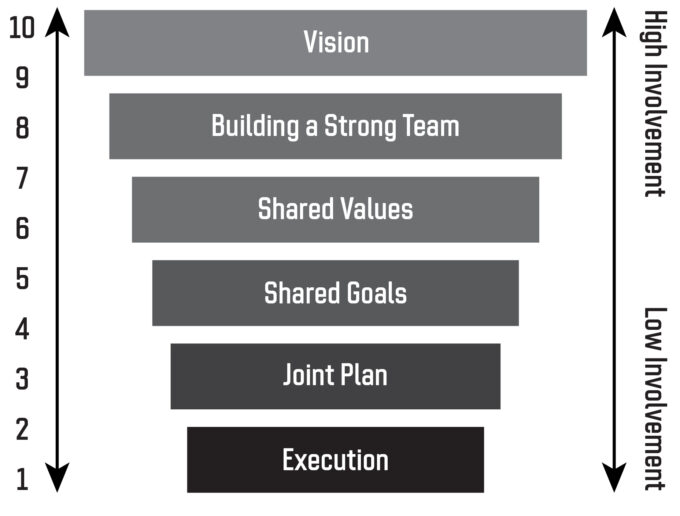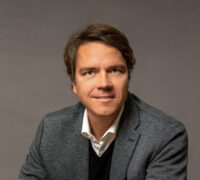
Trust is like a dance. Learn the steps to be a better leader
To waltz smoothly through office life, we need to balance vulnerability and honest feedback. And it’s perfectly fine to step on someone’s toes occasionally....
Audio available

by Patrick Flesner Published February 2, 2024 in Leadership • 7 min read
Leadership is a delicate dance between being actively involved and delegating effectively. Finding the right level of involvement is critical, as both micromanagement and a hands-off approach have their pitfalls.
At one end of the spectrum lies the risk of micromanagement, exemplified by Laura, the CEO of a fast-growing tech startup. In the company’s early stages, which were characterized by a flat organizational structure, Laura’s direct involvement in all aspects of the business was instrumental to the company’s success. Yet, as the organization’s size exceeded 100 employees, the same level of involvement began to backfire.
Laura’s desire to maintain control and reluctance to delegate decision-making led to significant delays, as team members awaited her approval for even minor tasks. This bottleneck not only slowed down the company’s growth but also culminated in frustration and high rates of attrition.
At the other end of the spectrum, some leaders exhibit an overly hands-off approach, often described as “laissez-faire leadership”. Keith, the CEO of an innovation unit within a public company, exemplifies this style. In his determination to avoid micromanagement, Keith distanced himself too much from day-to-day operations. This absence of leadership made his team feel unsupported and directionless, which led to uncoordinated initiatives, waning motivation, and ultimately, increased employee turnover.
The examples of Laura and Keith illustrate that the art of effective leadership is about striking the right balance of leadership involvement and team autonomy. To aid executives like Laura and Keith in finding the right level of involvement in the right situation, I have designed a leadership framework composed of “The Leadership Scale” and “Corrective Considerations”.
The Leadership Scale serves as a guide, acknowledging that different aspects of leadership demand varying levels of engagement. Foundational elements like defining organizational purpose and setting the vision necessitate high leadership involvement. As tasks become more operational, effective leaders transition into supportive roles, focusing on empowering team members to make decisions and take the lead.
The Leadership Scale includes the following key elements:
Establishing what the organization aspires to achieve long-term
Building a team that is worth more than the sum of its parts
Developing a common ethos that guides how the team wants to work together
Setting clear, measurable, and immediate goals that are not imposed on the team but developed by the team in a process orchestrated by the leader
Guiding the team to create detailed, actionable plans for what teams should do and deliver to achieve the shared goals
Ensuring that plans are carried out effectively

Real-world leadership requires a nuanced approach, and that is where the Corrective Considerations component comes into play. It involves considering the strengths and potential areas for growth of each team member (individual consideration) and the context and stakes associated with each task (situational consideration).
Consider the case of Emma, the CEO of a private equity-backed company reaping success in Scandinavia yet struggling to gain a foothold in the DACH market (Germany, Austria, and Switzerland). Despite a proactive team and robust efforts, sales were disappointing. In our coaching sessions, Emma shared her commitment to avoiding micromanagement. However, the stakes were high; demonstrating scalability outside Scandinavia was crucial for showcasing the company’s valuation potential to prospective acquirers.
This called for an adjustment in leadership involvement. Emma, recognizing the imperative to get deeply involved, delved into the sales funnel with her team. Through meticulous analysis, they discovered the DACH market’s unique consumer expectations necessitated specific product adjustments.

“Reduce your direct involvement gradually as you move from defining the organization’s purpose and vision to enabling successful execution.”
Upon implementing these changes, the company achieved product-market fit in the DACH market, resulting in a significant upswing in sales. Emma’s experience shows how to effectively apply the Leadership Scale. Executives should use it as a baseline while remaining flexible to adjust based on the Corrective Considerations. This dynamic approach ensures that leaders provide the right amount of guidance, delegating effectively where possible and stepping in when necessary.
Many leaders struggle with effective delegation, often equating their value with task engagement. But effective delegation is not an abdication of responsibility; it is an act of trust that amplifies team capabilities, encourages ownership, and drives the collective achievement of a high-performing team, freeing leaders to focus on the most critical aspects of their role.
Ultimately, mastering the balance of involvement is one cornerstone of effective leadership. It can help to create thriving company cultures, unleash creativity, promote empowered decision-making, boost team morale, and ensure a harmonious and impactful team performance – all while allowing leaders to channel their energies toward what truly needs their attention.

Leadership and Executive Coach
Patrick Flesner is a seasoned leadership and executive coach, a former professional handball player in the Handball-Bundesliga, a recognized bestselling author, and a renowned expert in the field of leadership. His diverse background, which includes experiences in top-level sports, roles as a partner in prestigious German law firms, a leadership position in a publicly traded company, and as a partner in a venture capital fund, has endowed him with a comprehensive and multifaceted perspective on leadership. Flesner’s growth mindset leadership philosophy – a central theme in his books The Leadership House – The Challenging Path to Becoming an Effective Leader and FastScaling – The Smart Path to Building Massively Valuable Businesses as well as in his LinkedIn Newsletter, Leadership Shots – extends to his various publications, keynotes, and his TEDx talk “How to Become an Effective Leader”. This ethos is the cornerstone of Unloq Growth, his advisory firm specializing in growth mindset-leadership. He is the author of the best-selling high-growth handbook for founders FastScaling and the leadership guide Leading Effectively.

April 3, 2025 • by Ben Bryant in Management
To waltz smoothly through office life, we need to balance vulnerability and honest feedback. And it’s perfectly fine to step on someone’s toes occasionally....
 Audio available
Audio available
March 27, 2025 • by Jennifer Jordan, Alexander Fleischmann in Management
Take our quiz to see if you're well-placed to implement new European rules on boardroom equality....
 Audio available
Audio available
March 20, 2025 • by Sat Dayal in Management
According to the 2025 Edelman Trust Barometer, trust in employers is declining for the first time. Here are practical measures to get back on track....
 Audio available
Audio available
March 18, 2025 • by Diana Markaki-Bartholdi in Management
New EU legislation requires stronger female representation on corporate boards. Here are ways to navigate the transition....
 Audio available
Audio available